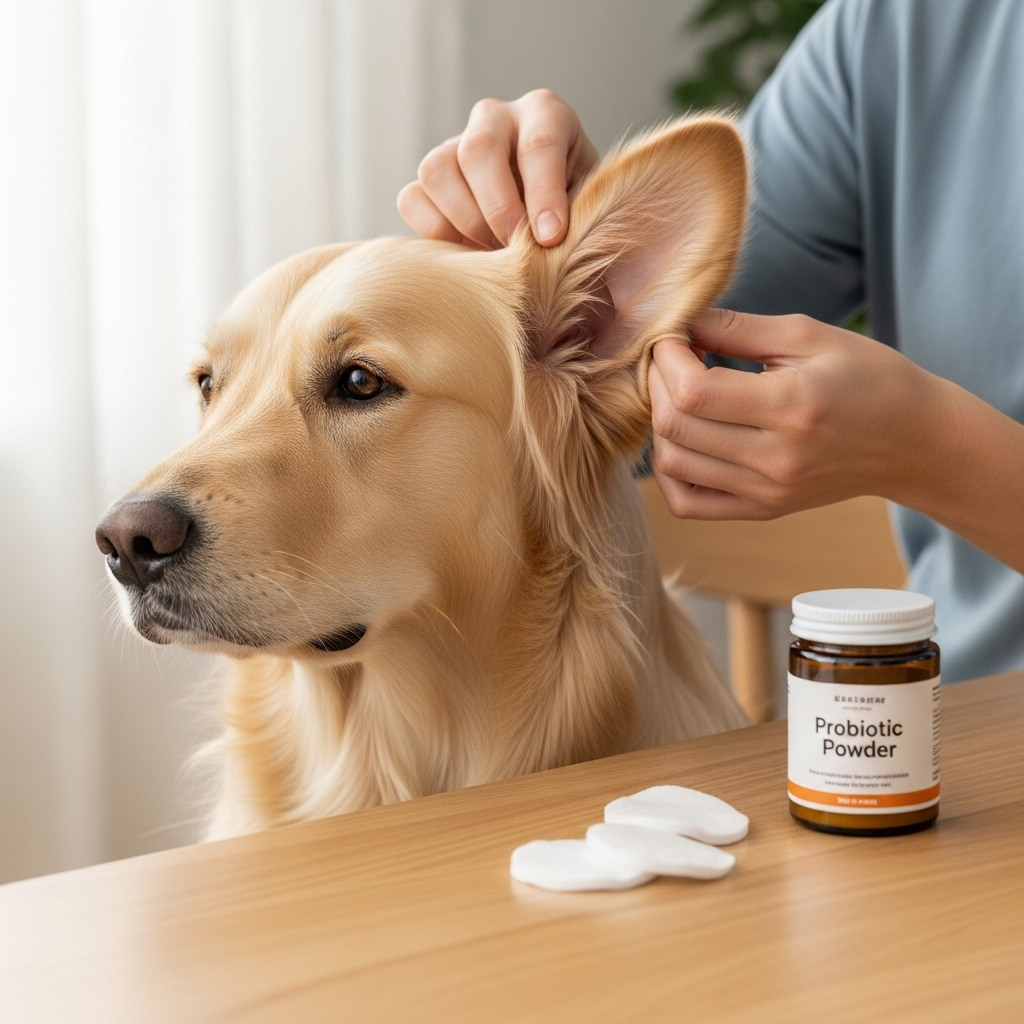Probiotics and Yeast Overgrowth in Dogs: A Starter Guide

Yeast overgrowth is a common problem in dogs, often showing up as itchy skin, red or greasy ears, odor, and recurrent infections. Many pet owners wonder whether probiotics can help control yeast by improving the microbiome and immune response. This guide explains what yeast overgrowth is, how probiotics might fit into treatment, practical steps to take, and safety considerations so you can discuss options with your veterinarian.
What is yeast overgrowth in dogs?
Yeast overgrowth usually involves the yeast Malassezia pachydermatis on the skin and in the ears. These organisms are normal residents of canine skin but can multiply excessively when the skin environment or immune defenses change. Common signs include:
- Itching and scratching
- Red, inflamed, or greasy skin
- Recurrent or persistent ear infections with a brown, waxy discharge
- Musty or “cheesy” odor
- Hair loss or scabbing in affected areas
Yeast overgrowth is usually a symptom of an underlying problem, such as allergies, moisture trapped in skin folds or ears, recent antibiotic use, endocrine disease (like hypothyroidism), or an impaired immune system.
How might probiotics help?
Gut-skin connection
Probiotics are live microorganisms that, when taken in adequate amounts, can confer health benefits. The idea behind using probiotics for skin issues is the “gut-skin axis”: a healthy gut microbiome can positively influence immune function and systemic inflammation, which may indirectly improve skin health.
Topical and skin microbiome effects
There is growing interest in topical products and shampoos that contain beneficial bacteria or prebiotics to help rebalance the skin microbiome. Restoring a healthy microbial balance on the skin could make it harder for yeast to dominate, though research is still emerging.
What the evidence says
Research specifically linking oral probiotics to improvement of Malassezia skin infections in dogs is limited but suggestive. Some studies in people and animals show that certain probiotic strains can modulate immune responses, reduce inflammation, and improve outcomes for some skin conditions. However, probiotics are generally considered an adjunctive strategy — not a standalone cure — for established yeast infections.
Topical antifungal therapies (shampoos and ear cleansers containing miconazole, ketoconazole, or chlorhexidine) and systemic antifungals when prescribed remain the primary treatments for significant yeast overgrowth. Probiotics can support overall skin health and help reduce recurrence when used alongside appropriate veterinary care.
Choosing and using probiotics safely
Which probiotic strains are used for dogs?
- Enterococcus faecium (a common canine probiotic strain)
- Lactobacillus species (e.g., L. acidophilus, L. rhamnosus)
- Bifidobacterium species
- Saccharomyces boulardii (a non-pathogenic yeast used for GI health)
Products formulated for pets and labeled with strain names and CFU counts are preferable. Human probiotics are sometimes used, but dosages and strains may not be ideal for dogs.
How to administer
- Follow product dosing instructions by weight and age, or follow your veterinarian’s guidance.
- Give probiotics consistently for several weeks to evaluate benefit; immune modulation and microbiome changes take time.
- If using topical probiotic or prebiotic products, follow the label directions for frequency and contact time.
When to avoid or use caution
- Dogs with severe immune suppression, central venous catheters, or critically ill patients may be at higher risk for rare probiotic-related infections — consult your veterinarian first.
- Live probiotics are generally safe in healthy dogs, but watch for digestive upset (soft stools or gas) when starting a new product.
- Avoid giving untested homemade preparations; choose reputable manufacturers with quality control.
Treatment plan outline (what a vet may recommend)
- Veterinary exam and cytology of the skin or ear to confirm yeast and assess severity.
- Treat active infection with appropriate topical antifungal shampoos, ear cleaners, and, when necessary, systemic antifungal medications.
- Identify and address underlying causes (allergies, endocrine disease, moisture, medications).
- Consider adjunctive probiotics (oral and/or topical) to support microbiome balance and reduce recurrence once active infection is controlled.
- Follow-up cytology to confirm improvement and adjust the plan as needed.
Pros and Cons
| Pros | Cons |
|---|---|
|
|
Practical tips for pet owners
- Have your vet confirm yeast by cytology before starting treatment — the signs of yeast can mimic bacterial or allergic problems.
- Use medicated shampoos and ear cleaners as directed; short-term topical therapy is often very effective.
- If you start a probiotic, give it for several weeks and monitor for GI side effects or changes in skin condition.
- Keep ears and skin folds dry and clean; address environmental factors that promote moisture.
- Discuss diet and allergy testing with your vet if infections keep returning.
Frequently Asked Questions
Q: Can probiotics cure yeast infections in dogs?
A: No — probiotics are unlikely to cure an active yeast infection on their own. They can be a helpful adjunct to veterinary-directed antifungal therapy and efforts to manage underlying causes.
Q: How long before I see improvement if I give probiotics?
A: Changes in gut microbiota and immune modulation may take several weeks. If you’re treating an active yeast infection, topical or systemic antifungal medication usually produces faster symptom relief.
Q: Which probiotic is best for dogs with yeast problems?
A: There’s no single “best” probiotic for yeast. Choose a veterinary-formulated product with specified strains and CFU counts (e.g., Enterococcus faecium, Lactobacillus spp.). Your vet can recommend a product suited to your dog’s needs.
Q: Are topical probiotic shampoos worth trying?
A: Some topical products aim to restore the skin microbiome and can be useful alongside medicated antifungal shampoos. Evidence is still growing, but they may help prevent recurrence in some dogs.
Q: Can probiotics make the problem worse?
A: In healthy dogs, probiotics rarely worsen yeast infections. However, if your dog is immunocompromised or critically ill, consult your vet before using live probiotics due to a very small risk of infection.
Key Takeaways
- Yeast overgrowth on skin and ears is common and usually signals an underlying issue.
- Probiotics can support gut and immune health and may help reduce recurrence, but they are not a standalone cure for active yeast infections.
- Primary treatment for active yeast typically involves topical or systemic antifungals prescribed by a veterinarian.
- Choose pet-specific, strain-labeled probiotic products and use them under veterinary guidance, especially in sick or immunocompromised dogs.
- Address underlying causes (allergies, moisture, medication history) to prevent recurrence.
Disclaimer: This guide is for general informational purposes only and does not replace veterinary advice. If you suspect your dog has a yeast infection or any other health problem, consult your veterinarian for diagnosis and appropriate treatment. Use probiotics and antifungal medications only as directed by a veterinary professional.

Leave a Reply